I was just perusing The Scent of Green Bananas, and came across this:
Name That Fruit!: Lanzones (Scent of Green Bananas)
I have never heard of these things, but I'm intrigued. Anybody know if these are available in the U.S.? Meliaceae is the mahogany family...
TSOGB is basically a food blog, but so fruit intensive that I read it semi-routinely, which is saying something because my tolerance for food blogs wears out pretty fast.
Saturday, August 22, 2009
Another pluot link...
Just a quickie here...wanted to link to a pluot post by my friends over at the Agricultural Biodiversity Weblog:
What I did on my holidays: The Pluot (Agricultural Biodiversity Weblog)
What I did on my holidays: The Pluot (Agricultural Biodiversity Weblog)
Fruit in Korea
I never reported back on my trip to Korea, mostly, I guess, because I hadn't reported back on anything here in months until very recently. But rest assured that I did go, and I did come back, and I did eat fruit while I was there.
Most of what I encountered was not overly exotic, although I did get to try the bokbunja that was recommended in the comments. This is a wine made from Rubus coreanus the Korean black raspberry. It was tasted about like what you'd expect from a black raspberry wine, but with a more substantial kick than I'd anticipated. (Of course, it was followed immediately by a couple of beers at a noraebang, so that might have had something to do with it). I thought it was pretty good. Apparently it also helps with impotence and sexual stamina, though neither was really an issue on this trip.
We also had hallabong, a relatively expensive but very tasty citrus fruit grown primarily on Jeju Island. It's vaguely tangelo-like, released from a Japanese breeding program in the 1970's (they called it Dekopon, but the Korean ones are named for a mountain on Jeju). I've seen a couple variations, so I'm not 100% confident in the pedigree, but the most probable seems to be:
Hallabong = Kiyomi x Ponkan
Kiyomi = Miyagawa x Trovita
Miyagawa = Citrus unshiu
Trovita = Citrus sinensis
Ponkan = Citrus reticulata
(Citrus unshiu x Citrus sinensis) x Citrus reticulata.
(For those unfamiliar with the Latin binomials, sinensis is the sweet orange, reticulata is mandarin/tangerine, and unshiu is the satsuma or mikan.
Anyway, very good. Unfortunately, I didn't get any pictures of it.
I did however get pictures of jujube (from a street market in Suwon):
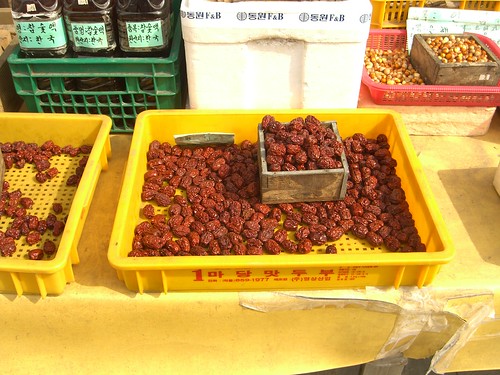
And some asian pears, apples, and kumquats:
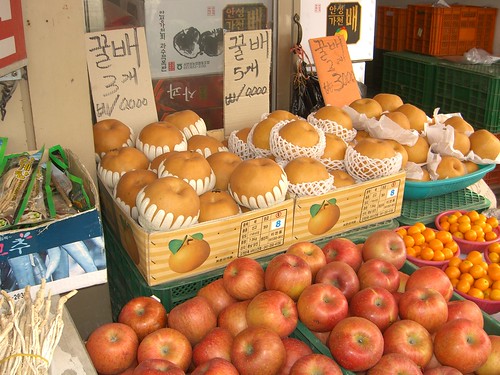
(I don't know what variety of apples they were, but it seemed to be the same variety everywhere. I had one and it was pretty uninspiring).
And some strawberries (there's also a few oranges and melons hiding in there):

(This seemed to be the only way strawberries were sold in Korea–in big styrofoam boxes. I think these were mostly 'Chandler', but I could be wrong (I'm pretty sure at least the ones I ate were). There were a couple of flats that might have been 'Camarosa' or something like that. They were even more shameless than US strawberry packers in hiding the bad fruit under the good, probably because in an opaque container it's easier to hide).
Also, though not a fruit, I also sampled bundagi, silkworm larvae:
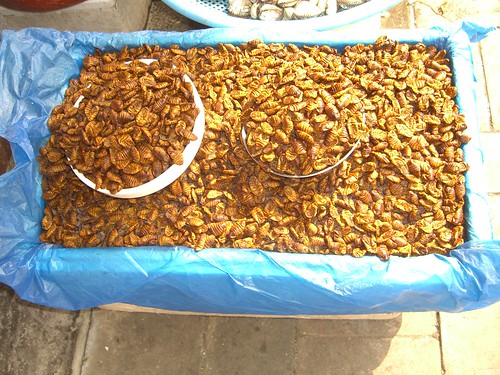
(I sampled some of these later, cooked not fresh, and wasn't too impressed, though my cousin told me the ones we had were not especially good ones...)
Most of what I encountered was not overly exotic, although I did get to try the bokbunja that was recommended in the comments. This is a wine made from Rubus coreanus the Korean black raspberry. It was tasted about like what you'd expect from a black raspberry wine, but with a more substantial kick than I'd anticipated. (Of course, it was followed immediately by a couple of beers at a noraebang, so that might have had something to do with it). I thought it was pretty good. Apparently it also helps with impotence and sexual stamina, though neither was really an issue on this trip.
We also had hallabong, a relatively expensive but very tasty citrus fruit grown primarily on Jeju Island. It's vaguely tangelo-like, released from a Japanese breeding program in the 1970's (they called it Dekopon, but the Korean ones are named for a mountain on Jeju). I've seen a couple variations, so I'm not 100% confident in the pedigree, but the most probable seems to be:
Hallabong = Kiyomi x Ponkan
Kiyomi = Miyagawa x Trovita
Miyagawa = Citrus unshiu
Trovita = Citrus sinensis
Ponkan = Citrus reticulata
(Citrus unshiu x Citrus sinensis) x Citrus reticulata.
(For those unfamiliar with the Latin binomials, sinensis is the sweet orange, reticulata is mandarin/tangerine, and unshiu is the satsuma or mikan.
Anyway, very good. Unfortunately, I didn't get any pictures of it.
I did however get pictures of jujube (from a street market in Suwon):

And some asian pears, apples, and kumquats:

(I don't know what variety of apples they were, but it seemed to be the same variety everywhere. I had one and it was pretty uninspiring).
And some strawberries (there's also a few oranges and melons hiding in there):

(This seemed to be the only way strawberries were sold in Korea–in big styrofoam boxes. I think these were mostly 'Chandler', but I could be wrong (I'm pretty sure at least the ones I ate were). There were a couple of flats that might have been 'Camarosa' or something like that. They were even more shameless than US strawberry packers in hiding the bad fruit under the good, probably because in an opaque container it's easier to hide).
Also, though not a fruit, I also sampled bundagi, silkworm larvae:

(I sampled some of these later, cooked not fresh, and wasn't too impressed, though my cousin told me the ones we had were not especially good ones...)
Plumcots vs. Pluots
Chip Brantley, whose pluot book I recently reviewed, has also recently penned an article on the distinction (or lack there of) between plumcots and pluots.
The Whole Truth About Pluots Versus Plumcots (Slate)
As I have mentioned before, I myself definitely favor "plumcot". I'm bothered by the idea of something trademarked becoming a generic term for something for which there is no real non-trademarked term, which would be the case if one insisted that plumcots are solely 50-50 plum-apricot hybrids (well, I suppose there's always "interspecific plum", but come on...). It restricts discussion and trade by people who don't hold the trademark, and it dilutes the trademark, so pretty much no one wins.
On a semi-related note, does anybody know the exact species make up of the "cherums" I've been seeing in the store? They've only come in big packages, so I haven't yet bought one, but they look pretty heavy on the plum side of things. I'd be stunned if some one could get any fertility of consequence in a cherry x plum hybrid without a bunch of backcrosses to one side or the other, but I'd be curious just which species they're working with. I'd wondered if maybe it was really a hybrid with the cherry-plum, Prunus cerasifera, but if you believe what little I've found online, it sounds like it involves actual cherries...
The Whole Truth About Pluots Versus Plumcots (Slate)
As I have mentioned before, I myself definitely favor "plumcot". I'm bothered by the idea of something trademarked becoming a generic term for something for which there is no real non-trademarked term, which would be the case if one insisted that plumcots are solely 50-50 plum-apricot hybrids (well, I suppose there's always "interspecific plum", but come on...). It restricts discussion and trade by people who don't hold the trademark, and it dilutes the trademark, so pretty much no one wins.
On a semi-related note, does anybody know the exact species make up of the "cherums" I've been seeing in the store? They've only come in big packages, so I haven't yet bought one, but they look pretty heavy on the plum side of things. I'd be stunned if some one could get any fertility of consequence in a cherry x plum hybrid without a bunch of backcrosses to one side or the other, but I'd be curious just which species they're working with. I'd wondered if maybe it was really a hybrid with the cherry-plum, Prunus cerasifera, but if you believe what little I've found online, it sounds like it involves actual cherries...
Mysticism and miniature fruit
I visited the Rosicrucian Egyptian Museum the other day (which, although I had originally worried it would be a weird cultish experience, was a really cool, professional museum, easily worth visiting for those with an interest in ancient Egypt) and came across this row of dwarf pomegranates along one wall. I didn't even recognize them until I saw the fruit, which was pretty obviously pomegranate-like. It gave the cultivar name as 'Nana', but I'm now thinking that's actually a botanical variety, and so there's got to be a cultivar name that goes with it (assuming they weren't just seedlings).
Anyway, I was delighted to find an unusual fruit growing there, and snapped a few pictures:
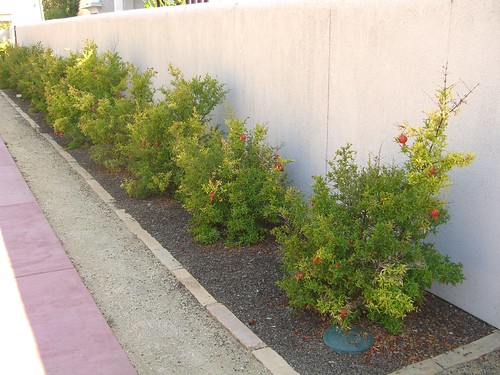
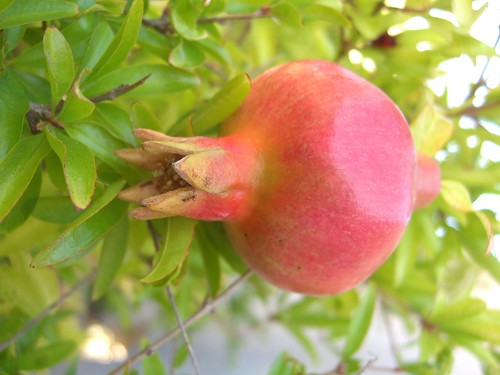
Anyway, I was delighted to find an unusual fruit growing there, and snapped a few pictures:


Friday, August 21, 2009
Fruit photos...
I hadn't logged into my Flickr account in ages, but when I did tonight, I discovered I had been contacted by a user called "frutticetum". I don't know anything about Mr. (or Ms.) frutticetum, but I really like their collection of photos, which includes a number of pretty unusual fruits—Quinces, medlars, aronia, elderberries, many more:
frutticetum's Photostream (Flickr)
While I'm at it, I might as well link to one more. Spidra Webster is an occasional commenter (and I'm hoping still a reader) around here, and she's got quite a collection of fruit images on Flickr as well:
Spidra Webster's stuff tagged with "fruit" (Flickr)
frutticetum's Photostream (Flickr)
While I'm at it, I might as well link to one more. Spidra Webster is an occasional commenter (and I'm hoping still a reader) around here, and she's got quite a collection of fruit images on Flickr as well:
Spidra Webster's stuff tagged with "fruit" (Flickr)
Food Forward
Sarah Spitz, from KCRW, sent along a link to Food Forward, an organization which harvests fruit trees in back yards and other locations and donates it to local food pantries. This is a great idea...many people (hopefully myself included, now that I finally own a decent chunk of land) tend to have way more fruit on their trees than they or their family will ever eat. Really, if you have more than a few good sized trees and don't have a huge family or a love of canning or fermenting, a lot of fruit is going to go to waste unless you give it away. A nice cause, and a good way to share all the unusual cultivars you've collected with the world. (From the looks of it this is a Southern California organization, but I'm not 100% sure. It's still a nice idea to donate your extra fruit to a food pantry, even if there's no Fruit Forward in your area...)
Smoothie Quest
As much as I like to occasionally gripe about the selection of fruit in grocery stores, I have to say the number of interesting fruits in them has certainly improved in the last decade. My three year-old and I decided at dinner we were going to make smoothies tonight. We already had blueberries at home, and I had half a flat of strawberries from work in the car (I was planning an informal tasting of the five leading selections, which was cut short when one of my daughters wolfed down one clamshell's worth in a matter of seconds). So we headed to the store and went fruit shopping.
She made her old dad proud, choosing a really eclectic mix of fruits, each of which I sampled before dropping them into the mix:
Cherimoya:

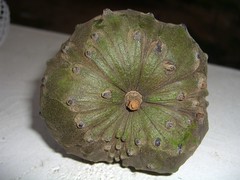
Wow...I'd forgotten how much I liked cherimoya. The aroma is wonderful. And it worked really well in a smoothie. The only downside was digging out all those seeds (which are hopefully working on germinating right now...)
Honeydew Nectarine:
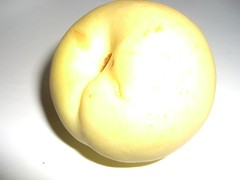
I had never heard of this before...and I really wasn't missing much. It tasted like a blend of really bland nectarine and underripe melon. It might not have been fully ripe, but the texture suggests it was close. Still, a pale yellow nectarine is interesting. (My picture is kind of washed out...oh well.
Golden Kiwi:
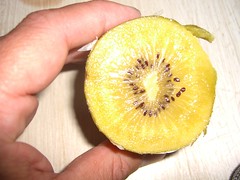
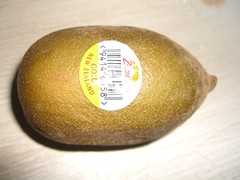
I've been seeing these for a while, but this is actually the first time I've bought one. Interesting that the shape and skin are so distinctive--if I had to guess, this is Actinidia chinensis, not the usual Actinidia deliciosa. It was pretty good, but nothing spectacular. It was a tad past its peak, I think, but it went into the mix just fine.
Manzano Bananas:
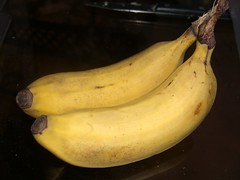
I really like these things. I probably should have waited for them to darken more (it does improve the flavor), but they're really good even at this stage. I ate one while I worked and gave the other to my daughter, so none made it in the smoothie (we bought some standard bananas too, which served just fine).
We also got blackberries (which my daughter had nearly reduced to smoothies already by the time we got them back to the car--she was enjoying shaking the bag vigorously), a nectarine, more standard versions of kiwi and banana, and an apple.
The smoothies were good and we got to discuss lots of different fruit species. How many three year olds do you know who can tell you all about cherimoyas?
(I didn't really have a point to this post, other than just basking in all the fruit I just bought).
She made her old dad proud, choosing a really eclectic mix of fruits, each of which I sampled before dropping them into the mix:
Cherimoya:


Wow...I'd forgotten how much I liked cherimoya. The aroma is wonderful. And it worked really well in a smoothie. The only downside was digging out all those seeds (which are hopefully working on germinating right now...)
Honeydew Nectarine:

I had never heard of this before...and I really wasn't missing much. It tasted like a blend of really bland nectarine and underripe melon. It might not have been fully ripe, but the texture suggests it was close. Still, a pale yellow nectarine is interesting. (My picture is kind of washed out...oh well.
Golden Kiwi:


I've been seeing these for a while, but this is actually the first time I've bought one. Interesting that the shape and skin are so distinctive--if I had to guess, this is Actinidia chinensis, not the usual Actinidia deliciosa. It was pretty good, but nothing spectacular. It was a tad past its peak, I think, but it went into the mix just fine.
Manzano Bananas:

I really like these things. I probably should have waited for them to darken more (it does improve the flavor), but they're really good even at this stage. I ate one while I worked and gave the other to my daughter, so none made it in the smoothie (we bought some standard bananas too, which served just fine).
We also got blackberries (which my daughter had nearly reduced to smoothies already by the time we got them back to the car--she was enjoying shaking the bag vigorously), a nectarine, more standard versions of kiwi and banana, and an apple.
The smoothies were good and we got to discuss lots of different fruit species. How many three year olds do you know who can tell you all about cherimoyas?
(I didn't really have a point to this post, other than just basking in all the fruit I just bought).
Saturday, August 15, 2009
The Perfect Fruit: Good Breeding, Bad Seeds, and the Hunt for the Elusive Pluot, by Chip Brantley
The Perfect Fruit: |
What seems like an eternity ago, when I was still posting semi-regularly here, Chip Brantley contacted me about doing a series of fruit breeder profiles for his website, CookThink. Then a few personal crises intervened on my side, things got postponed, work picked up, and it never happened. But in the course of our conversation he mentioned that he was writing a book on pluots. I thought this was a pretty cool idea--there aren't many decent books on stone fruit, and certainly not on pluots specifically, and I said I'd like to read it when it was done.
That was probably a year ago. I'd honestly kind of forgotten about it. When you talk to serious fruit enthusiasts, you'll find that an awful lot of them are writing books about fruit. I think it comes from reading too many books about fruit. (For the record, in keeping with my obligation is a fruit fanatic, I'm writing a book, on grape breeders, or at least I was until my hard drive crash ate about half of it. I have to say my enthusiasm has waned a bit since). But anyway, I didn't necessarily expect that I would ever see the pluot book.
But I have to give Chip credit: not only did he write the pluot book, but he remembered my interest in it, and a couple weeks ago a copy appeared in my mail box.
I haven't been so pleased with a fruit book in a long time. It's not because it's the perfect book on pluots. I'd have written a very different book on pluots: more species info, more chromosomes, more history, more Luther Burbank. My book would have been twice as long, and it would have had lots of photos and tables, and probably nobody but me and a handful of stone fruit breeders would have been able to stomach reading it from cover to cover.
Brantley didn't write that, book, and I'm glad he didn't. Because this book does something else that no other book I've read has really done, at least not as well, and that is to capture what it's like on the inside of the fruit industry. The pluot is important to this story mostly because it's the central theme, but it in a very real sense, it's not what the book's about. The book is about the people and the business that have grown up around stone fruits--the breeders, the growers, the shippers, even the grocery stores. But one could have written the same story about strawberries, or apples, or citrus.
When people ask me what I do for a living, the next question (if there is a next question--I get a lot of blank stares of incomprehension) is what it is I do all day. And I dutifully try to explain, which inevitably entails a long complicated explanation of what it is the company does and how I fit in there and then I notice they're either losing interest or have wound up with one of those blank stares after all. This book is that explanation, only readable and interesting. For the people I really want to understand the business I work in, I will be recommending this book.
But even if you don't have a fruit breeder in the family that you're seeking to understand, I think this is still an important book, because so few people really understand the machinery that stands behind the produce they buy at the store. There's a lot of ignorance and a lot of misconceptions about agriculture and about farmers (there's virtually no misconceptions about fruit breeders, because hardly anybody knows we exist, though we do occasionally get accused of genetic engineering).There is a lot more complexity to the stone fruit industry than probably occurred to most folks, which is probably really the case with most industries. And as we follow both the development of the pluot and the players on the stone fruit stage, of the shifting loyalties and million dollar gambles, we start to get a picture of the constant balancing act these growers need to perform.
I've had so many conversations with people in which the grower is cast as some evil profiteer who cares nothing about quality, gleefully foisting crappy tasting fruit onto the hapless customers and cashing his fat checks. Many people don't seem to realize that the vast majority of growers want to grow good fruit. They want a product they can be proud of, that they can feel good putting their family name on. Unfortunately, many are working within the bounds of a system that doesn't put much value on quality, where price is dictated by volume and convenience. It's also a system in which margins are often slim, and the grower who chooses to emphasize quality but doesn't find a way to get paid for it sometimes can't pay his bills at the end of the season. (And sometimes it doesn't matter what they do--some seasons no one makes money).
Stone fruit have suffered a great deal in the current system, though perhaps not uniquely so. I didn't think I liked fresh peaches until I was 28 and in grad school in Arkansas, and I actually tasted tree-ripe peaches. A good peach is just about as good as fruit can get. Same goes for plums. I haven't had a plum I truly liked from a grocery store yet, nor even from a farmer's market, but I've had plenty of good ones out of people's back yards. Mass producing food is inevitably a compromise, but the stone fruit seem to have been more compromised than most.
The book ends on a hopeful note, that maybe this system is starting to change, and the pluot is held up as an example of how things are shifting. And I hope he's right. Certainly store-bought pluots have raised the bar for stone fruit. But I'm still continually disheartened by how many people just don't notice. People who will happily munch on the nine-month-old 'Delicious' apple and not notice the distinct resemblance to damp cardboard, or buy boxes full of half-green strawberries. I think somehow some of these people just like the concept of eating fruit in some way completely detached from the actual experience of doing it. These are the people who have set the tone for a long time. We have crappy produce in our stores solely because people like this will happily pay a reasonable price for them. If the only fruit people paid money for was good fruit, then there would only be good fruit in the stores, and growers would be paid to produce good fruit. That's how capitalism works.
As I have said, it's not as technically or historically focused as many single fruit books are, which was initially a bit of a disappointment to me. (It's worth noting that the Washington Post's review, while positive, thinks he gets too caught up in "long tedious fruit genealogies", so much of this is probably in the eye of the beholder). There's not a ton of science, beyond a basic explanation of how breeding is done and a brief overview of Prunus. Nor does Luther Burbank, father of the plumcot and probably the greatest plant breeder ever, get his fair share, in my view. Instead the star of this story is Floyd Zaiger, probably the closest thing to Burbank alive today, who took Burbank's idea and turned it into commercially viable varieties. I've wanted to write a piece about Zaiger Genetics for ages, but for now you'll just have to settle for this article or the Dave Wilson's Nursery catalog of Zaiger varieties, always an entertaining read in itself.
Brantley's writing is engaging, occasionally humorous, and infused with passion for his subject. His excitement about pluots has that slightly unfathomable quality that I find all good fruit authors have. In the narrative of his pluot research, I can see shadows of my own journeys of discovery into various fruit. Not everyone will get that, I suspect. But I also suspect most people, even those with no particular interest in pluots, will be taken by the string of characters Brantley visits in the course of his quest. The book is a quick, easy, and rewarding read, and I heartily recommend it to any one who eats fruit (which I would assume is essentially any one reading this blog).
You can buy it from Amazon and Barnes and Noble, among other places.
Friday, August 14, 2009
"Organic" does not necessarily equal "good"
I was pleased to find this article in the LA Times today:
'Organic' Label Doesn't Guarantee Quality or Taste (L.A. Times)
This article nicely captures my feelings on the subject. I've got nothing against organic food. I eat a fair amount of it. A lot of it's pretty good. But you know what? A lot of non-organic food is pretty good, too. I bugs me to no end when people treat the organic label as though it's some magic talisman of awesome yumminess. It's just a label. A stunningly arbitrary label, actually. And one that doesn't take into account the vast majority of things that influence quality.
But I also have issues with the big company vs. small company bias lots of people, including this article's author, seem to have (but in the interest of full disclosure, I work for one of those big companies...though it's all relative--we're no Monsanto or Dole). In general, yes, big agribusiness has not done well by us in the flavor department (though to be fair, by constantly seeking to buy things for as cheap as possible rather than insisting on the importance of quality, we consumers have basically done it to ourselves), but there are many, many small farms that produce mediocre food too. And there are some big companies who produce pretty decent fruit.
'Organic' Label Doesn't Guarantee Quality or Taste (L.A. Times)
This article nicely captures my feelings on the subject. I've got nothing against organic food. I eat a fair amount of it. A lot of it's pretty good. But you know what? A lot of non-organic food is pretty good, too. I bugs me to no end when people treat the organic label as though it's some magic talisman of awesome yumminess. It's just a label. A stunningly arbitrary label, actually. And one that doesn't take into account the vast majority of things that influence quality.
But I also have issues with the big company vs. small company bias lots of people, including this article's author, seem to have (but in the interest of full disclosure, I work for one of those big companies...though it's all relative--we're no Monsanto or Dole). In general, yes, big agribusiness has not done well by us in the flavor department (though to be fair, by constantly seeking to buy things for as cheap as possible rather than insisting on the importance of quality, we consumers have basically done it to ourselves), but there are many, many small farms that produce mediocre food too. And there are some big companies who produce pretty decent fruit.
Subscribe to:
Posts (Atom)


